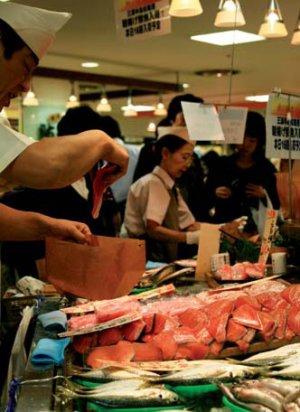Industry Focus: The Price of Japan's Food

By Ken Worsley
Self-sufficiency based on a point system?
Japan is the world’s largest net importer of food. Nearly 90 percent of wheat consumed in Japan is imported, and about 18 million tons of corn is purchased each year from the United States alone. When global food prices rise—whether due to speculation, unfavorable weather conditions or higher oil prices—Japanese firms and consumers find themselves at the mercy of external forces as price increases pinch budgets.
The Ministry of Agriculture, Forestry and Fisheries intend to do something about this. Masatoshi Wakabayashi, who served as Agriculture Minister under both Prime Ministers Abe and Fukuda, announced that Japan should strive to reach 50 percent food self-sufficiency based on caloric consumption by the year 2015. In fiscal 2007, Japan’s self-sufficiency rate rose for the first time in 13 years, gaining 1 percent to end up at 40 percent.
 Japan wants to increase it’s food self sufficiency from 40 percent to 50 percent—but can you change consumer culture?
Japan wants to increase it’s food self sufficiency from 40 percent to 50 percent—but can you change consumer culture?
In other words, the government is in for an uphill battle if it truly intends to reach 50 percent food self-sufficiency sometime within the next seven years. In late fiscal 2007, poisoned gyoza dumplings from China and rising costs of bread and pasta helped drive more domestic consumers back to purchasing rice—the price of which is kept artificially high by the very same Ministry of Agriculture that wants Japanese consumers to buy more domestic farm products.
Although the fear of imported food and the threat of rising prices has spilled over into fiscal 2008, it seems difficult to predict a significant rise in Japan’s food self-sufficiency rate for this year. That is, unless the Ministry of Agriculture has a trick up its sleeve.
At the press conference announcing that Japan’s self-sufficiency rate had increased from 39 percent to 40 percent, new Agriculture Minister Seiichi Ota told reporters, “We will make efforts both on the production and consumption sides to ensure this trend.”
Ota’s statement piqued my interest. It’s nothing new to say that supply side measures will be taken to provide Japan’s farmers with a boost, but it seems odd to see a Cabinet minister talking about stimulating demand amongst consumers. “What are they going to do?” I thought to my cynical self, “Make some kind of point card scheme for domestic food purchases?”
Unfortunately, it seems I was right. About two weeks after the press conference at which Ota made his comment, the Asahi Shimbun reported that the government was considering introducing a point card that would reward shoppers for purchasing domestically produced meat and vegetables. According to the newspaper, customers would be able to use earned points to get more domestic produce.
How much taxpayer money would such a program waste in order to achieve the goal of having consumers buy more domestically produced food? Cards and scanners need to be made, databases need to be built, and in the end, food needs to be purchased to be given away. Of course, for firms able to secure the lucrative government contracts involved, this sounds like a license to print money.
On the consumer side, this idea makes little sense. Food purchases reflect economic reality at the household level. The price gap between imported and domestic produce is so great that those who already buy domestic will continue to do so, and those who buy imported goods often do so because they have no other financial choice—and wage growth is sluggish at best. Will consumers switch to domestic food and pay prices many times higher just to get some points?
This is what it seems to come down to: The government is willing to bribe the public in order to make steps toward achieving an arbitrary goal of 50 percent food self-sufficiency. Consumer purchasing behavior is deeply ingrained, and changing it would represent a serious accomplishment. Perhaps this could be better done by resolving inefficiencies in the agriculture industry itself rather than treating supermarket shopping as some kind of game.
At the time of this writing, Yasuo Fukuda had stepped down as Prime Minister and a new PM had not yet been elected and the new cabinet is unknown. Although it is assumed by the author that Mr. Ota will not continue in his current position—due to financial improprieties—there is no way to tell just yet who will be Agriculture Minister when this issue comes to print.
PHOTOGRAPHY: Sarah Noorbakhsh





